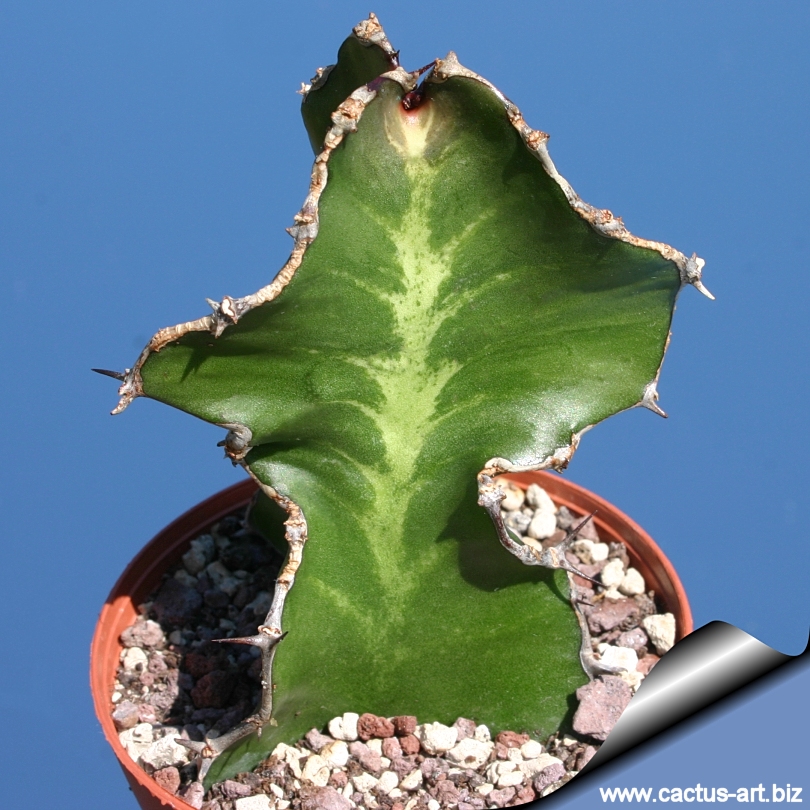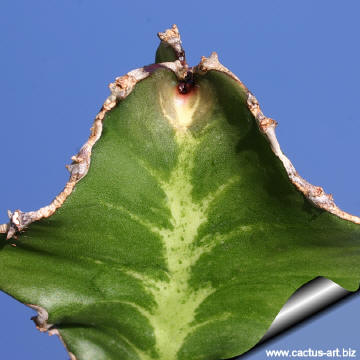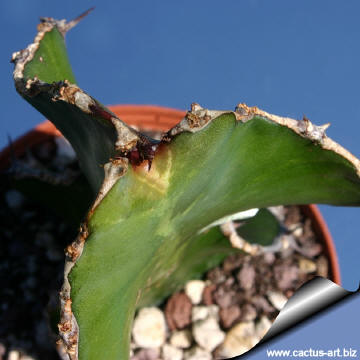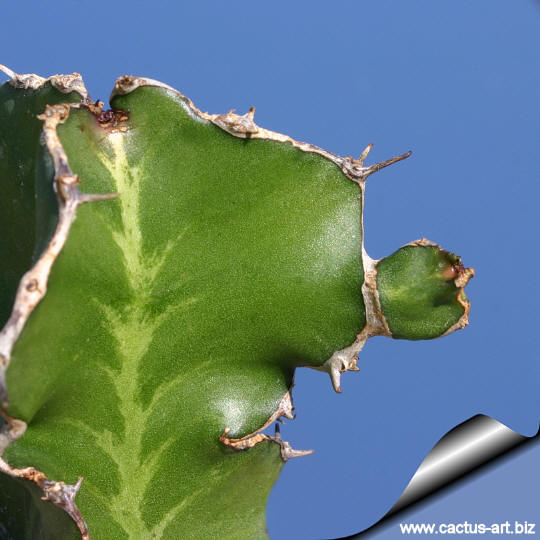|
|
|

Euphorbia halipedicola, is a classic succulent candelabra tree with a
tall erected trunk crowned with a whorl of jointed branches. Similarly
to E. cooperi it is characterized by periods of rapid growth, designated
by the wide stem sections, and minimal growth which are the narrow
sections.
|
|
Description: E. halipedicola is another of the
Euphorbia cooperi-like plants with some subtle differences. It is a rare
succulent shrub or small candelabra tree up to 4 m high, usually with a
single trunk crowned with a whorl of segmented branchlets.
The branches do not split again, unlike the common
tree Euphorbia. Old dead branches hang underneath the the compact crown
for a while. Over time all lower branches sheds in a continual process
leaving the top branches to accentuate the candelabra form.
Stems: The solitary trunk is naked, straight,
grey to dark grey or brown with a gnarled appearance up to 3 m high.
Round holes on the trunk indicate where old branches have fallen off.
Branchlets green to yellowish-green often with
very ornamental lime green marbled marking, constricted into
oblong segments up to 40 cm long, 3-4-angled with thin, distinctly
undulating wings.
Leaves: No clearly visible, very small, inconspicuous that fall
early, they are sometimes seen on the branch ridges among the spines.
Spines: Spine shields more or less continuous, forming a horny
margin on the wings.
Flowers: Deep yellow to orange, in clusters above the spines
Fruit: Distinctly 3-lobed when mature, approx 8 × 20 mm, on a
pedicel up to 8 mm long.
Blooming season (Europe): Flowers are usually produced in winter
Euphorbia halipedicola is superficially similar
Euphorbia cooperi in appearance but it has much larger
segments and the stem ridges had strongly wavy margins.
|

For its beauty and distinctive silhouette nearly all the botanical
gardens have one. |

The outer rib-ridges have continuous, narrow and dark spine shields
running along the paired spines. |
|
Advertising
|
|
|
|
|
Family: Euphorbiaceae
Accepted
scientific name: Euphorbia
halipedicola L.C. Leach1970
Common English Names include:
Zig-zag Candelabra Tree
Origin: Coastal Tanzania, Mozambique, Zimbabwe and
possibly southern Malawi. (Type locality coastal plain near Lake Gambue,
Mozambique)
Habitat: In mixed woodland, in
seasonally flooded areas on deep alluvial soils. Altitude up to 500 m
Conservation status: Listed in
CITES appendix 2.
Etymology: Named for Euphorbus, Greek physician to
Juba II, King of Mauretania.
The species name 'halipedicola' comes
from Latin 'halipedum', 'coastal plain'; and
Latin '-cola', 'inhabiting'; for the preferred
habitat. .
|
|
|
|

Cultivation: It is an easy species to grow that is suited for any
well drained soil in full sun. But young plant are happy growing
indoors. Give the plant an airy growing medium which mainly consists of
non organic material such us clay, pumice, lava grit, and only a little
peat or leaf-mould. Water regularly during the active growing season
from March to September. No water should ever be allowed to stand around
the roots. Keep almost completely dry in winter. It is a moderately fast
grower, and will quickly become large landscape masterpieces in just
5-10 years. Only downside is from strong winds, the columns often smash
into each other, causing permanent scarring... best to plant in such a
location where winds are not a big issue. It is a long lived plant
and once established, it will be content in its position and with its
soil for years. It can tolerate moderate shade, and a plant that has
been growing in shade should be slowly hardened off before placing it in
full sun as the plant will be severely scorched if moved too suddenly
from shade into sun. Like quite small pots, repot in very later winter,
early spring. Frost tender, frost free zones only.
Propagation: It is
easy to propagate by cuttings in late spring to summer, just take
a cutting of the plant let it dry for 1 or 2 weeks and stuff it in the
ground (preferably dry, loose, extremely well draining soil).
Warning: Its latex is
poisonous. Can irritate the skin and can produce a burning sensation in
the throat if ingested. Latex irritates the eye and can cause blindeness.
If contact is made with this white sap, take care to not touch face or
eyes before washing hands with soap and water.
Gardening: This tree can be grown in large, rocky, well-drained
soil in gardens in drier areas, however, because of the latex and
spines, is not advisable for a family garden. It is very drought
resistant but very susceptible to frost.


|
|